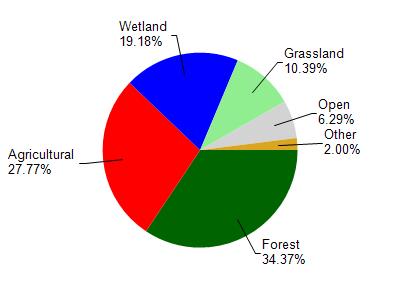Waushara
No
No
No
Fish and Aquatic Life
Overview
Little Silver Lake, in the Pine and Willow Rivers Watershed, is a 50.39 acre lake that falls in Waushara County. This lake is managed for fishing and swimming and is currently not considered impaired.
Date 2011
Author Aquatic Biologist
Historical Description
Source: 1970, Surface Water Resources of Waushara County Silver Lake (Near Wild Rose) T-20-N, R-11-E, Sections 28,29,32,33 Surface Acres = 48.3; S.D.F. = 1.33; Maximum Depth = 52 feet.
A medium size, bard water seepage lake located two miles east of Wild Rose. This is a deep lake with 70 percent of the basin greater than 20 feet deep. The littoral bottom materials consist of marl and sand. There is an intermittent outlet to Willow Creek. A thermocline develops at 22 feet. The fishery includes walleye, perch, largemouth bass, bluegill, white crappie, rock bass, pumpkinseed, green sunfish, bullhead, and white sucker. Rainbow trout were once stocked in this lake. Bluewing teal nest near the lake. Puddle ducks are present during spring and fall migrations. Hunting is allowed with permission. There are 56 cottages or dwellings present, one resort and one boat rental place. Access consists of one town road with parking and one undeveloped site. The major use problem of this site is fluctuating water levels.
Date 1970
Author Surface Water Inventory Of Wisconsin
General Condition
Little Silver Lake (WBIC 247700) was assessed during the 2018 listing cycle; new total phosphorus sample data were clearly below 2018 WisCALM listing thresholds for the Recreation use and the Fish and Aquatic Life use. For the Fish Consumption use new fish tissue analysis showed no need for specific fish consumption advisories for this lake. This water was meeting these designated uses and was not considered impaired.
Date 2017
Author Ashley Beranek
Condition
Wisconsin has over 84,000 miles of streams, 15,000 lakes and milllions of acres of wetlands. Assessing the condition of this vast amount of water is challenging. The state's water monitoring program uses a media-based, cross-program approach to analyze water condition. An updated monitoring strategy (2015-2020) is now available. Compliance with Clean Water Act fishable, swimmable standards are located in the Executive Summary of Water Condition in 2018. See also the 'monitoring and projects' tab.
Reports
Management Goals
Wisconsin's Water Quality Standards provide qualitative and quantitative goals for waters that are protective of Fishable, Swimmable conditions [Learn more]. Waters that do not meet water quality standards are considered impaired and restoration actions are planned and carried out until the water is once again fishable and swimmable
Management goals can include creation or implementation of a Total Maximum Daily Load analysis, a Nine Key Element Plan, or other restoration work, education and outreach and more. If specific recommendations exist for this water, they will be displayed below online.
Monitoring
Monitoring the condition of a river, stream, or lake includes gathering physical, chemical, biological, and habitat data. Comprehensive studies often gather all these parameters in great detail, while lighter assessment events will involve sampling physical, chemical and biological data such as macroinvertebrates. Aquatic macroinvertebrates and fish communities integrate watershed or catchment condition, providing great insight into overall ecosystem health. Chemical and habitat parameters tell researchers more about human induced problems including contaminated runoff, point source dischargers, or habitat issues that foster or limit the potential of aquatic communities to thrive in a given area. Wisconsin's Water Monitoring Strategy was recenty updated.
Grants and Management Projects
| Project Name (Click for Details) | Year Started |
|---|
|
|
Monitoring Projects
| WBIC | Official Waterbody Name | Station ID | Station Name | Earliest Fieldwork Date | Latest Fieldwork Date | View Station | View Data |
|---|
| 247700 | Silver Lake | 10018749 | Silver Lake -- Access Off Little Silver Lake Rd | 7/20/1993 | 9/26/2018 | Map | Data |
| 247700 | Silver Lake | 703023 | Silver Lake - (Near Wild Rose) Deep Hole | | | Map | Data |
| 247700 | Silver Lake | 10040980 | Little Silver Lake - Monitoring Well | 7/30/2013 | 5/28/2021 | Map | Data |
| 247700 | Silver Lake | 703100 | Silver Lake - Deep Hole | 11/5/1980 | 8/3/2025 | Map | Data |
| 247700 | Silver Lake | 10054680 | Silver Lake Spring | | | Map | Data |
| 247700 | Silver Lake | 10007460 | Silver Lake (Little Silver Lake Town of Springwater) | 7/27/1999 | 3/8/2024 | Map | Data |
|

Watershed Characteristics
Silver Lake is located in the Pine and Willow Rivers watershed which is 302.08 mi². Land use in the watershed is primarily forest (34.40%), agricultural (27.80%) and a mix of wetland (19.20%) and other uses (18.70%). This watershed has 377.48 stream miles, 11,273.01 lake acres and 33,136.61 wetland acres.
Nonpoint Source Characteristics
This watershed is ranked High for runoff impacts on streams, Not Ranked for runoff impacts on lakes and High for runoff impacts on groundwater and therefore has an overall rank of High. This value can be used in ranking the watershed or individual waterbodies for grant funding under state and county programs.However, all waters are affected by diffuse pollutant sources regardless of initial water quality. Applications for specific runoff projects under state or county grant programs may be pursued. For more information, go to surface water program grants.